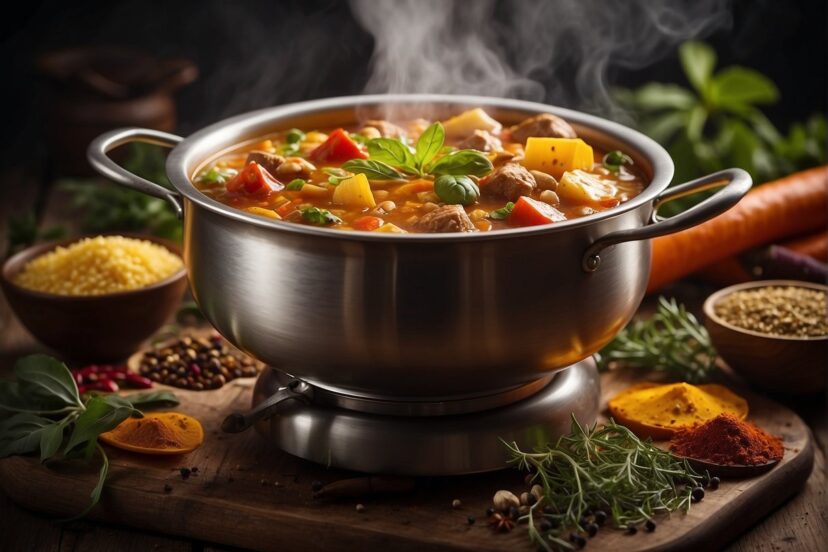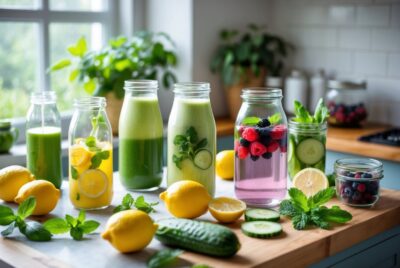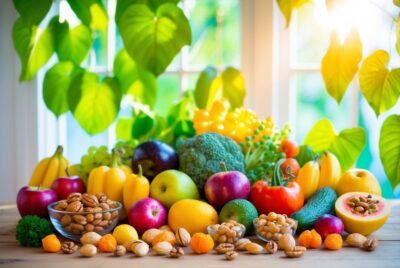Vegetarian Stew: Meat-Free Comfort Food
*We may earn a commission for purchases made using our links. Please see our disclosure to learn more.
Vegetarian Stew: A Hearty Guide to Wholesome, Meat-Free Comfort Food
Vegetarian stew is a staple in my kitchen for its versatility and the way it easily adapts to any season. A mélange of vegetables simmered together doesn’t just make for a wholesome meal; it’s a canvas for creativity. Each spoonful offers not only a burst of flavor but also a wealth of nutrition. Crafting a nutritious stew is more than following a recipe; it’s about understanding the delicate balance of flavors and the nutritional profile of each ingredient.

I take pride in ensuring my vegetarian stews are not just satisfying but also packed full of the good stuff – vitamins, minerals, and fiber. Root vegetables like carrots and potatoes add heartiness, mushrooms provide an umami depth, and a variety of bell peppers infuse color and vitamin C. Lentils or beans can be added for an extra punch of plant-based protein, turning the stew into a complete meal.
The process of making a vegetarian stew is just as important as the ingredients. I start with a good glug of olive oil, sautéing onions and garlic to lay down a rich flavor foundation. Then, building layers of flavors with herbs and spices while allowing the vegetables to release and absorb these notes is crucial. Simmering gently, I give the ingredients time to meld and soften into a comforting pot of nutritious goodness, ensuring every bite is as nourishing as it is delicious.
Essential Ingredients for Vegetarian Stew
In my preparation of vegetarian stews, I rely on a foundation of key ingredients that bring out the rich flavors and nutritional value. These ingredients are categorized into vegetables, base & broth, and protein enrichment, each playing a vital role in creating a hearty stew.

Vegetables
Vegetables are the heart of any vegetarian stew, contributing textures and flavors that define the dish. I consider some to be indispensable:
- Potatoes: A starchy staple, often diced for a satisfying bite.
- Carrots: Sliced or chopped, these add a hint of sweetness.
- Onions: Typically diced, providing a base flavor for the stew.
- Mushrooms: Offer a meaty texture, which can be quartered or sliced.
- Celery: Chopped for a subtle, earthy undertone.
- Sweet Potatoes: An alternative to potatoes, they add color and a unique flavor profile.
- Peas: For a pop of color and a burst of sweetness.
- Leafy Greens: Kale or spinach, wilted in at the end for a nutritional boost.
Base & Broth
The foundation of the stew’s liquid reflects the overall richness and depth:
- Vegetable Broth: Acts as the main liquid component, enveloping the ingredients in warmth. I prefer a well-seasoned broth for added flavor.
- Tomato: Crushed or diced, tomatoes contribute a tangy brightness and thicken the broth.
- Garlic: A few cloves, minced, infuse the stew with an aromatic kick essential to the base.
Protein Enrichment
For a fuller, more satisfying stew, I incorporate plant-based proteins that complement the vegetables:
- Lentils: A hearty choice that thickens the stew and stands up well to long cooking, enhancing the texture.
- Chickpeas: These bring a pleasant, nutty taste and a gratifying crumble to the stew.
By paying attention to these essential ingredients, I ensure that my vegetarian stew is not only flavorful but also comforting andnutritionally balanced.
Cooking Techniques

When I create a vegetarian stew, I consider my cooking method carefully to ensure flavors are thoroughly developed and ingredients reach their perfect texture. Whether I use a stovetop or an automated cooker like an Instant Pot, each approach has its own benefits, particularly for dairy-free and vegan stews.
Stovetop Methods
Dutch Oven & Simmering:
I find that using a Dutch oven on the stovetop yields the best results for a hearty vegetarian stew. I start by heating some olive oil over medium-high heat. Once hot, I add aromatic vegetables like onions and garlic, sautéing until they’re translucent. Then, I incorporate the rest of my vegetables, searing them to lock in flavors. What’s crucial here is the slow simmering after adding broth or water. This method allows for the slow release of flavors, and I keep my pot partially covered, stirring occasionally, which ensures even cooking.
- Sautéing: I always sauté my base vegetables until they’re just softened, not browned, to preserve their natural tastes.
- Layering: I add spices next, cooking them briefly to release their aromas, then follow with my other ingredients.
- Simmering: A gentle simmer, not a vigorous boil, is key to blending flavors without overcooking the veggies.
Instant Pot & Slow Cooker
One-Pot Convenience:
An Instant Pot provides a one-pot solution that’s both time-saving and energy-efficient for making vegetarian stew. I start by using the sauté function to cook my base vegetables in olive oil, then I add my seasonings and the rest of my ingredients. I make sure to seal the pot correctly and set it to the stew function. The pressure-cooking technique infuses the ingredients quickly with flavor and produces a tender texture in a fraction of the time compared to stovetop cooking.
- Slow Cooker: For a slow cooker, I layer my ingredients similarly and set it on low for a longer cooking duration, usually for several hours, which is perfect for when I want to come home to a ready-to-eat vegan stew.
Both methods are excellent for making a dairy-free stew, as they allow for the flavors to meld wonderfully, all while maintaining the integrity of each ingredient. Utilizing an Instant Pot or a slow cooker can also help avoid the occasional stirring required with a stovetop method, making them convenient options for busy days.
Seasonings and Flavor Enhancers for Vegetarian Stew

In creating a robust vegetarian stew, the use of seasonings and flavor enhancers is pivotal. I focus on incorporating a variety of herbs, spices, condiments, and sauces to amplify the taste without relying on meat as a flavor base.
Herbs & Spices
- Salt & Pepper: I consider salt and black pepper fundamental. Salt accentuates the natural flavors of the vegetables, while freshly ground black pepper adds a subtle heat.
- Garlic Cloves: Minced garlic cloves are essential for a deep, pungent taste.
- Fresh Parsley and Thyme: These herbs introduce a freshness to the stew and pair well with an array of vegetables.
- Rosemary: This aromatic herb, when used in moderation, provides a distinctive woodsy flavor.
- Cumin and Bay Leaves: Cumin adds a warm and earthy note, while bay leaves impart a floral aroma that enhances the complexity of the stew.
Condiments & Sauces
- Soy Sauce: A splash of soy sauce can deepen the savory notes due to its umami properties.
- Tomato Paste: I use tomato paste to infuse richness and a concentrated tomato flavor which serves as the backbone for many stews.
Utilizing these seasonings and flavor enhancers judiciously can turn a simple vegetarian stew into a dish that stands up to its meat-based counterparts in both flavor and satisfaction.
Vegetarian Stew and Side Dishes

When I prepare a vegetarian stew, I like to consider side dishes that complement its hearty and warming nature. The right side can turn the stew into a well-rounded meal. I focus on grains and breads for heartiness and salads and vegetables for a fresh contrast.
Grains & Breads
For grains, I find rice to be a staple side since its mild flavor doesn’t overshadow the stew. A simple white rice works well, but for more nutritional value, brown rice or even quinoa can be excellent choices. Here’s a quick guide:
- Rice: Serve it plain or lightly seasoned.
- Quinoa: Offers a protein boost and a nutty flavor.
Crusty bread is another favorite of mine. It’s perfect for soaking up the flavorful broth, and a baguette or sourdough loaf brings a satisfying crunch and texture to the meal. Freshly baked garlic bread or spicy pumpkin cornbread can provide an additional layer of flavor.
Salads & Vegetables
Moving onto salads, they should be light yet flavorful. I enjoy pairing my stews with a crisp, green salad dressed in a zesty orange vinaigrette. It’s refreshing and balances the heartiness of the stew. Here’s what I might include:
- Classic cucumber salad: Cool and crisp.
- Greek salad: Bold and robust.
For cooked vegetables, garlic mashed potatoes offer a creamy and comforting side that melds wonderfully with the texture and taste of the stew. A dish of lightly buttered steamed vegetables, such as broccoli or carrots, also adds color and variety to the plate.
Storing and Reheating of Vegetarian Stew

When I make a hearty vegetarian stew, not only do I enjoy it fresh, but I always make enough to have leftovers. Proper storage and reheating techniques are essential to maintain the stew’s flavor and texture. For refrigeration, I ensure the stew is cooled to room temperature before placing it in air-tight containers. In the fridge, I can keep my stew for up to a week, which makes it a fantastic make-ahead meal for busy days.
For longer storage, freezing is my go-to method. Here’s how I do it:
- Cool the stew to room temperature.
- Portion the stew into freeze-safe airtight containers or bags.
- Label the containers with the date to track how long it’s been stored.
- Place in the freezer, which should be at 0°F (-18°C).
My stew will keep for up to six months in the freezer, though I find it best to consume it within the first few months for peak quality.
When it comes time to reheat my leftover stew, either from the fridge or after thawing it from the freezer, I follow these steps:
- Refrigerated Stew:
- Heat on the stovetop over medium heat until the stew is warmed throughout.
- Frozen Stew:
- Allow the stew to thaw mostly.
- Reheat over medium heat on the stovetop.
By adding a splash of water or vegetable stock, I can reintroduce moisture as needed. Stews tend to thicken upon cooling due to the starches from ingredients like potatoes, so this little trick helps restore the original consistency. Whether from the fridge or the freezer, I always ensure my stew is piping hot before serving.
Frequently Asked Questions
In this section, I cover some of the most common inquiries about preparing vegetarian stews, providing tips on ingredients, flavor enhancement, and cooking techniques to help you craft a delicious and satisfying meal.
1. What are the essential ingredients for a traditional vegetable stew?
For a traditional vegetable stew, you’ll need a base of hearty vegetables like potatoes, carrots, and onions. Adding celery, garlic, and mushrooms can give your stew profound depths of flavor.
2. How can I make a hearty vegetarian stew that is both filling and nutritious?
To make your stew both filling and nutritious, incorporate a variety of vegetables, legumes like beans or lentils, and whole grains such as barley or quinoa. These ingredients add plenty of fiber and protein to keep you satisfied.
3. Which herbs and spices are recommended to enhance the flavor of vegetarian stews?
Herbs such as thyme, rosemary, and bay leaves are classic for adding depth to stew flavors. For spices, paprika, cumin, and black pepper can introduce warmth and complexity to your dish.
4. Can you suggest any vegetarian stew variations that are inspired by Mediterranean cuisine?
A Mediterranean-inspired stew might include ingredients like zucchini, eggplant, tomatoes, and bell peppers. Adding herbs like oregano and basil, along with a splash of olive oil, can bring a touch of the Mediterranean to your table.
5. What are some easy techniques for making a vegetable stew more flavorful?
One easy technique is to sauté your onions until golden before adding other vegetables, which can add a caramelized flavor. Additionally, deglazing the pot with a splash of wine or vegetable broth can lift the savory notes of your stew.




